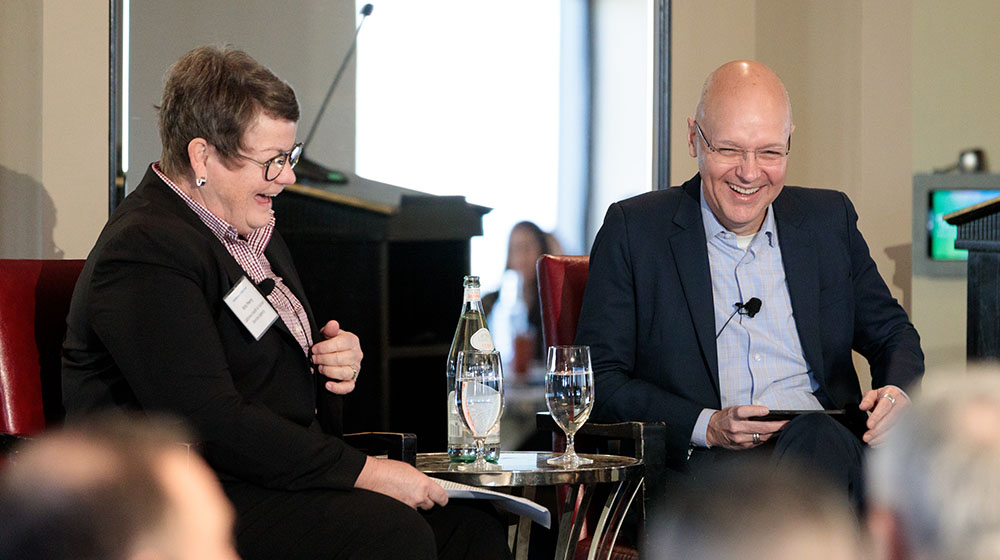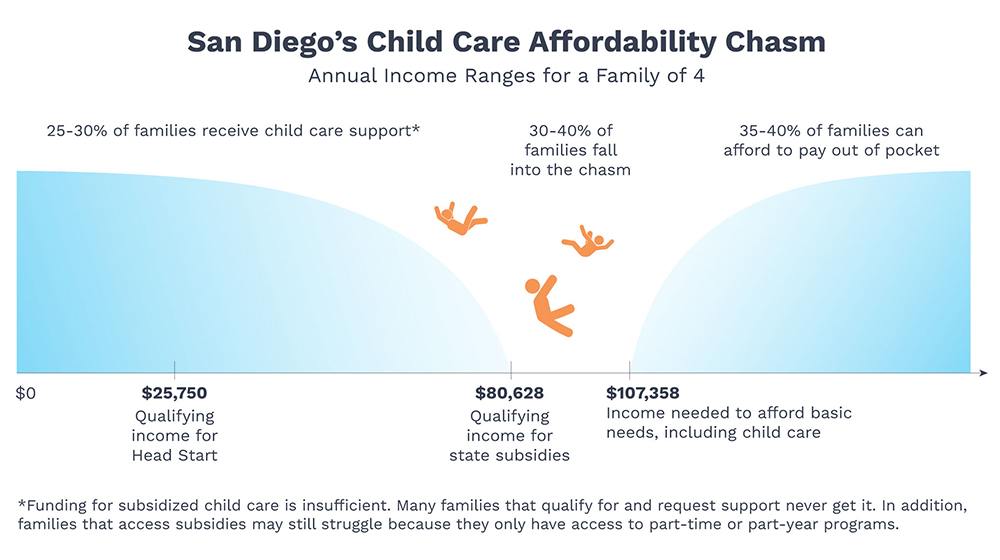
Parents of young children who come to the San Diego Workforce Partnership for help with their career have a range of prior experiences and future aspirations, but they share a common challenge: finding child care they trust and can afford that covers the hours they need to work. San Diego’s child care system is in crisis.
To support our commitment to 2Gen solutions—helping parents find family-supporting work while ensuring that their children are healthy and learning—we undertook a study of the region’s child care system and the connection between parents’ child care struggles and the economy. With funding and partnership from The San Diego Foundation’s Early Childhood Initiative, the Workforce + Child Care was released on January 13 at a press conference that also announced the San Diego Regional Chamber of Commerce’s new Supporting Working Families report about family friendly benefits. Extensive media coverage of the press conference signified that concerns about the child care issue are growing.
The release of the reports was followed by a summit about the Workforce + Child Care findings on January 30, 2020. The gathering in downtown San Diego featured local, state and national leaders and experts and focused on actions we can take in our region to better support working parents.
Here’s what we learned:
1. Supporting working parents is good for business and the economy

“High quality child care builds a strong future, but our families’ inability to secure child care also has major effects for business and economy.”
– Nathan Fletcher, San Diego County Supervisor, District 4
Attracting and retaining talent is important for San Diego region employers, who are desperate to keep jobs filled given our record-low unemployment rate—2.8 percent in January 2020. When parents leave the labor force due to child care struggles, or when a parent is an unreliable employee due to sketchy child care arrangements, the employer is faced with substantial productivity, recruitment and training costs. Council for a Strong America estimates that the annual cost to the economy of the child care crisis is $57 billion, including lost revenue, productivity and earnings.
How does this show up in San Diego? One symptom of the crisis is that San Diego County has the second lowest female labor force participation rate among ten major metro areas in the U.S. If we were to match Boston’s rate, an additional 74,000 women would be working in our region—a staggering toll of talent that is sidelined.
San Diego County has the second lowest female labor force participation rate among ten major metro areas in the U.S. If we were to match Boston’s rate, an additional 74,000 women would be working in our region. #2Gen Click To Tweet
2. The San Diego region is in the midst of a child care crisis

Workforce + Child Care found that San Diego region child care is hard to find, hard to afford, often inconvenient and of varying quality. The report presents extensive evidence of the crisis, but one statistic that landed hard with the summit audience: there’s a gap of 190,000 between the number of available licensed child care slots in the region and the number of children who need care because all of their parents work. What this means for working parents looking for care is that they make lots of calls to child care centers only to learn that there are no spots available and the waitlist is years long.
The search for child care is even harder for first responders, health care workers and others who work non-traditional hours. Jack Schaeffer, San Diego Police Officers Association president, explained that his parent members just can’t find options that work for the swing and graveyard shifts that they must take every four months so parents often end up leaving the force. The Association is raising money for a 24-hour child care center to help address this challenge.
3. The child care crisis hits middle income working families hardest
Child care in San Diego County is very expensive—more than $17,000 per year on average for infant and toddler care for example. While low income families qualify for free or subsidized care (though slots are limited and only the very lowest income families are assured of landing a spot) and well-off families can afford to pay out of pocket, middle income working families are caught in the middle with few options.
A family of four with two young children in our region can probably afford child care if the parents make over $107,000 annually, as about 35-40% of families do. But those many families—about 30-40% by our estimate—who make too much to qualify for assistance or can’t secure it, yet can’t afford to pay out of pocket, are out of luck. One symptom: as of late January, 2,034 families in San Diego County were on the waitlist for child care support, and most will languish there for months or years.

4. We can and must act locally to address the crisis

More funding for child care from the state and federal governments is needed urgently, and speaker Kris Perry, the deputy secretary for the California Health and Human Services Agency, promised that new investments are on the way. But summit speakers also made it clear that local players can do a lot to help working families.
Some recent actions by local government show that policymakers are taking steps to address the child care crisis. On January 28, Supervisor Kristen Gaspar introduced, and the supervisors passed, a plan to review all County properties to find spaces suitable for child care for County employees. And in mid-2019, the San Diego City Council approved a package of zoning and permitting reforms that encourage the inclusion of child care in new developments.
Local philanthropists can spur innovation and growth in the field. A new initiative at The San Diego Foundation alongside new investments by Price Philanthropies and other local funders are launching new child care centers and improving the quality of existing care.
5. Making jobs more family friendly is key

“One hundred percent of businesses need to do something.”
– Julia Barfield, U.S. Chamber of Commerce Foundation
Making jobs more family friendly will help businesses appeal to and keep employees. Businesses can do this in myriad of ways, including offering on-site child care, paid leave, telecommuting opportunities and other benefits.
Sam Whiting, Director of Global Engagement at Boeing, shared that they are constantly thinking about ways to help employees perform better at work and allow them to do what they need to do at home. A couple of the benefits Boeing offers include 12 weeks paid parental leave and up to $10,000 in reimbursements for adoption fees. With the growing challenges of finding good talent, Whiting shares that asking, ”How can we make it so [employees] want to move within the company, not out of it?” is imperative.
While on-site child care is wonderful when possible, it is not an option for most employers. However, every employer can, for example, examine its work schedules to make them more family friendly—which means both flexible and predictable. Paid family leave is another very powerful benefit employers can offer to augment what the state provides since the weeks and months after a baby is born are critical for the health of the baby and mother and it also helps with child care challenges.
More ideas on how employers can better support working families such as providing lactation rooms, flextime, and creating a family friendly work culture can be found in the Workforce + Child Care and Supporting Working Families reports.
6. Asking what parents need is the first step toward supporting them

Curious about how you might support working parents in your workplace? Ask them. Virtually all of the family friendly benefits shared at the event stemmed from direct feedback and conversations with employees.
Sarah Hassaine, Manager of Inclusion and Diversity at Qualcomm shared that they implemented flex schedule and only schedule meetings between 10 a.m. and 3 p.m.—two decisions that cost the company nothing and have been incredibly valued by parents.
“There isn’t one answer, we need to be flexible and offer flexibility.”
– Jack Schaeffer, President, San Diego Police Officers’ Association
What’s next?
We all have a part to play in solving the child care crisis in San Diego County. We need everyone at the table. When government, philanthropy and businesses work together, innovation occurs. We can do this. And we can start now by making changes to include more parents in our current workforce while investing in their children, our future workforce.
We all have a part to play in solving the child care crisis in San Diego. We need everyone at the table. When government, philanthropy and businesses work together, innovation occurs. #2Gen Click To Tweet
For more ideas on how you can help, visit childcare.workforce.org.
